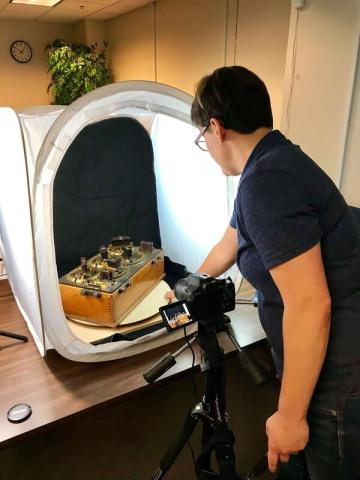
A potentiometer is an instrument for measuring voltage by comparing an unknown voltage with a known reference voltage, standard cell. This particular instrument, created by Otto Wolff of Berlin and sold by Central Scientific Co. (circa 1915), measures a voltage of 15 volts with an accuracy of .0001 V. This potentiometer is one of several scientific instruments on display in the History of Science Collections, loaned to the University of Oklahoma Libraries by the department of chemistry and biochemistry and the Homer L. Dodge department of physics and astronomy. The collection is curated by Stu Ryan, David Ross Boyd professor, emeritus, department of physics and astronomy.
While the physical object is too fragile to be handled, 3D scans of these objects allow for deeper interaction and preservation. Emerging technologies librarian Kristi Wyatt explains how the digital model was created and potential implications.
Potentiometer by libedge on Sketchfab
“The potentiometer model was created through a process called photogrammetry, which is measurement with light using digital photographs,” said Wyatt. “It was placed on a large turntable, lit by diffused lighting, and a photo was taken of the object every ten degrees until a full rotation had been completed, making one circuit. From there, the height of the camera was raised, slightly tilted down and again a complete rotation was captured for another circuit. There were about four circuits total for this model. Finally, these photos were placed in a software that takes the measurements from each photo and creates a model.”
Wyatt said the goal for the photogrammetric process is to create a 3D digital surface that replicates the real subject as closely as possible in shape and color.
“If this is done accurately using a rule-based approach, one has image sequences that can be qualitatively evaluated, contain quantitative estimates of measurement uncertainty, can be reused by others, and preserved for future generations,” said Wyatt.
However, the novelty of this technology presents challenges for digital preservation.
“Because standards for the long-term preservation of 3D data have not yet been established within the library community, OU Libraries has taken an active role in supporting research in this area through its involvement in the LIB3DVR Project, in collaboration with Virginia Tech and Indiana University,” said Zack Lischer-Katz, postdoctoral research fellow. “We are also monitoring ongoing standards and best practices development work by the Community Standards for 3D Data Preservation (CS3DP) Project, the Building for Tomorrow project, and the 3D digitization project at the Smithsonian Institution.”
Learn more about photogrammetry and contact our emerging technologies team to support your next project.